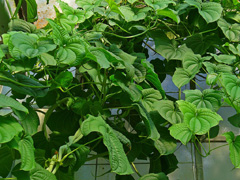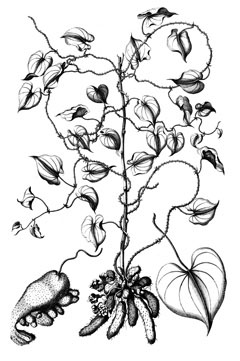 |
|
https://edibleplants.org/ |
 |
| https://edibleplants.org/ |
Translate this page:
Summary
Lesser Yam or Dioscorea esculenta is a perennial, climbing plant with a tuberous rootstock. It has spines and it can climb up to about 2.4 m high and spread up to 1.8 m across. The leaves are often heart-shaped It is often cultivated as root crop in tropical areas in East Asia. Though some varieties can be poisonous, most are edible. The tuber has a yellow or white flesh. It is cooked and used as vegetable. It has a sweet and pleasant flavour similar to that of sweet potato or chestnuts.
Physical Characteristics

 Dioscorea esculenta is an evergreen Perennial Climber growing to 3 m (9ft) by 0.5 m (1ft 8in) at a fast rate.
Dioscorea esculenta is an evergreen Perennial Climber growing to 3 m (9ft) by 0.5 m (1ft 8in) at a fast rate.
See above for USDA hardiness. It is hardy to UK zone 9. The flowers are pollinated by Wind, Insects.
Suitable for: light (sandy) and medium (loamy) soils and prefers well-drained soil. Suitable pH: mildly acid, neutral and basic (mildly alkaline) soils. It can grow in semi-shade (light woodland) or no shade. It prefers moist soil.
UK Hardiness Map
US Hardiness Map
Synonyms
Dioscorea aculeata L. Dioscorea fasciculata Roxb. Dioscorea papillaris Blanco Dioscorea papuana Warb
Plant Habitats
Edible Uses
Edible Parts: Root
Edible Uses:
Root - cooked and used as a vegetable[ 300 ]. Sweet and pleasant, with a flavour somewhat like sweet potato or chestnuts[ 301 ]. The tubers are oval, up to 20cm long and 6 - 8cm in diameter. Each plant can produce 5 - 20 tubers. The flesh is yellow or white and the average tuber weight may be 250 - 1,000g, though larger ones can weight 3,000g[ 300 , 418 ].
References More on Edible Uses
Medicinal Uses
Plants For A Future can not take any responsibility for any adverse effects from the use of plants. Always seek advice from a professional before using a plant medicinally.
None known
References More on Medicinal Uses
The Bookshop: Edible Plant Books
Our Latest books on Perennial Plants For Food Forests and Permaculture Gardens in paperback or digital formats.

Edible Tropical Plants
Food Forest Plants for Hotter Conditions: 250+ Plants For Tropical Food Forests & Permaculture Gardens.
More

Edible Temperate Plants
Plants for Your Food Forest: 500 Plants for Temperate Food Forests & Permaculture Gardens.
More

More Books
PFAF have eight books available in paperback and digital formats. Browse the shop for more information.
Shop Now
Other Uses
References More on Other Uses
Cultivation details
A plant of the drier to wet tropical lowlands, where it is found at elevations up to 900 metres. It grows best in areas where annual daytime temperatures are within the range 28 - 32°c, but can tolerate 17 - 45°c[ 418 ]. It can be killed by temperatures of 9°c or lower[ 418 ]. It prefers a mean annual rainfall in the range 800 - 2,000mm, but tolerates 600 - 8,000mm[ 418 ]. Plants like a well-defined dry season of 2 - 5 months[ 418 ]. This species will grow in drier climates than other yams, so long as the rainfall is evenly distributed through the year[ 300 ]. Succeeds in full sun and also in light shade[ 418 ]. For best yields, this species requires a deep, well-drained, sandy loam that is not liable to water-logging[ 300 ]. This species will succeed in poor gravelly soils, especially if enriched with organic matter[ 300 ]. Prefers a pH in the range 5.5 - 6.5, tolerating 4.5 - 8.5[ 418 ]. Daylengths of more than 12 hours are preferred during the early growing season since this encourages vegetative growth; daylengths of less than 12 hours towards the end of the growing season will encourage tuber formation and development[ 300 ]. Crops take 7 - 10 months to mature, yields of 7 - 20 tonnes per hectare have been achieved[ 300 ]. There are some named varieties[ 300 , 301 ]. Two main forms of this plant are sometimes recognised:- Var fasciculata (Roxb.)Prain. & Burk. Arose in cultivation and has no spines. Var spinosa (Roxb.)Prain. & Burk. Is believed by many botanists to be the wild form. It has thorny roots protecting the crown of the rootstock[ 266 , 300 ]. This is a variable characteristic, however[ 300 ]. The plant rarely produces flowers[ 418 ]. A dioecious species, both male and female plants need to be grown if seed is required.
References Carbon Farming Information and Carbon Sequestration Information
Temperature Converter
Type a value in the Celsius field to convert the value to Fahrenheit:
Fahrenheit:
The PFAF Bookshop
Plants For A Future have a number of books available in paperback and digital form. Book titles include Edible Plants, Edible Perennials, Edible Trees,Edible Shrubs, Woodland Gardening, and Temperate Food Forest Plants. Our new book is Food Forest Plants For Hotter Conditions (Tropical and Sub-Tropical).
Shop Now
Plant Propagation
Seed - not normally used to propagate this species. Cuttings of tubers. Pieces of tuber, each weighing around 50 - 80g with dormant buds, are planted in situ 4 - 8cm deep with the stem pointing downwards[ 300 ]. The cut tuber is often first left in the sun for several hours to promote wound healing and reduce the risk of fungal infection[ 300 ].
Other Names
If available other names are mentioned here
Ama-yama-imo, Apali, Birch-rind yam, Buga, Couche-couche douce, Cu tu gai, Diba, Gan shu, Gembili, Goa potato, Harau, Hisu, Huwi butul, Huwi jahe, Huwi kamayung, Huwi landak, Kangar, Kawai, Kembili, Kemili, Kizahangu Kodi, Manalu, Man-chuak, Musilam valli kilangu, Pana, Sasniali, Sathni, Silakadom, Sinnavalli-kelangut, Siruvalli kilangu, Siu-chue-shue, Su nialu, Sudo, Suthni, Taitu, Taitukava, Tippa tiga, Tivvitiga, Tonga, Tu gai, Tugi, Tungo, Ubi-arumanis, Ubitorak, Ufi Lei, 'Uhilei, Uwhikaho, Wale, Ware, Yava-ala,
Native Range
TROPICAL ASIA: India (northeast), Indonesia (Papua), Papua New Guinea, Laos, Myanmar, Thailand, Vietnam
Weed Potential
Right plant wrong place. We are currently updating this section.
Please note that a plant may be invasive in one area but may not in your area so it's worth checking.
Conservation Status
IUCN Red List of Threatened Plants Status : This taxon has not yet been assessed.

Growth: S = slow M = medium F = fast. Soil: L = light (sandy) M = medium H = heavy (clay). pH: A = acid N = neutral B = basic (alkaline). Shade: F = full shade S = semi-shade N = no shade. Moisture: D = dry M = Moist We = wet Wa = water.
Now available:
Food Forest Plants for Mediterranean Conditions
350+ Perennial Plants For Mediterranean and Drier Food Forests and Permaculture Gardens.
[Paperback and eBook]
This is the third in Plants For A Future's series of plant guides for food forests tailored to
specific climate zones. Following volumes on temperate and tropical ecosystems, this book focuses
on species suited to Mediterranean conditions—regions with hot, dry summers and cool, wet winters,
often facing the added challenge of climate change.
Read More
Expert comment
Author
(Lour.) Burkill.
Botanical References
Links / References
For a list of references used on this page please go here
A special thanks to Ken Fern for some of the information used on this page.
Readers comment
| Add a comment |
|
If you have important information about this plant that may help other users please add a comment or link below. Only comments or links that are felt to be directly relevant to a plant will be included. If you think a comment/link or information contained on this page is inaccurate or misleading we would welcome your feedback at [email protected]. If you have questions about a plant please use the Forum on this website as we do not have the resources to answer questions ourselves.
* Please note: the comments by website users are not necessarily those held by PFAF and may give misleading or inaccurate information.
To leave a comment please Register or login here All comments need to be approved so will not appear immediately.
|
Subject : Dioscorea esculenta
|
|
|
|